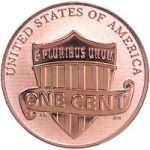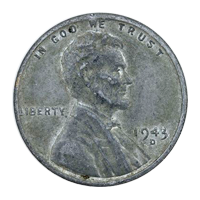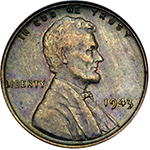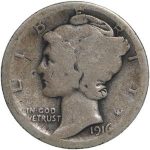
What Does the Shield Stand For On US Coins?
What Does the Shield Stand For On US Coins? The Shield Symbol Is On Coins of Old And Contemporary. But, What Does It Mean? The
In 1943, the greatest generation ever to live was in Europe fighting in World War II. The US Mint was home trying to find a way to decrease their use of copper so the copper could be used to produce shell casings, bullets, bombs and guns for the troops.
The mint experimented with materials such as ceramics, glass, other metals, and plastics. They finally settled on a low-carbon steel cent plated with zinc. There were many problems to come for the new steel cent.
 When first introduced the new cent was shunned. The brand new 1943 cents with their silver color were often mistaken for dimes. Due to the magnetic property of the steel, magnets in vending machines used to pick up steel slugs would also reject the legitimate steel cents. Imagine today a vending machine that uses a penny! Times have changed. To make matters worse, the two metals are not compatible in moist atmospheres. The steel cores would rust while the zinc plating oxidized. Even the sweat off of your hands would cause the coins to corrode.
When first introduced the new cent was shunned. The brand new 1943 cents with their silver color were often mistaken for dimes. Due to the magnetic property of the steel, magnets in vending machines used to pick up steel slugs would also reject the legitimate steel cents. Imagine today a vending machine that uses a penny! Times have changed. To make matters worse, the two metals are not compatible in moist atmospheres. The steel cores would rust while the zinc plating oxidized. Even the sweat off of your hands would cause the coins to corrode.
In 1943, while the mint was making the switch from copper to steel, some copper planchets remained undiscovered in tote bins and other coining equipment. A few were accidentally produced by all three mints. Thankfully, due to the mint’s change to steel cents, there was plenty of copper for the war effort.
Although the steel cent was not great to deal with, in the end, the copper released for the war effort was enough to meet the needs of 2 cruisers, 2 destroyers, 1,243 flying fortresses, 120 field guns, and 120 howitzers. This was enough copper to make 1.25 million shells for our big field guns. Shortly after the war, the mint started to transition back to the normal composition of the copper cent.
In 1944, the mint began to recycle spent shell casings from the war and use them for cent production. Pure copper ingots were combined with the 70% copper shell casings to bring the alloy up to the pre-1943 95% copper, 5% zinc combination. The same error that happened in 1943 now happened in 1944.
 There are two explanations given why there are steel cents in 1944. The first one is that when the mint was switching back over to the copper alloy, a few of the steel planchets prepared for 1943 dated cents remained in the system and were struck as 1944 cents. The other explanation is that the Philadelphia mint used the leftover steel planchets to produce 25 million two-franc coins for recently liberated Belgium. Given the poor quality control that characterized the wartime Philadelphia mint, it is likely that some of these planchets found their way into a tote filled with cent planchets.
There are two explanations given why there are steel cents in 1944. The first one is that when the mint was switching back over to the copper alloy, a few of the steel planchets prepared for 1943 dated cents remained in the system and were struck as 1944 cents. The other explanation is that the Philadelphia mint used the leftover steel planchets to produce 25 million two-franc coins for recently liberated Belgium. Given the poor quality control that characterized the wartime Philadelphia mint, it is likely that some of these planchets found their way into a tote filled with cent planchets.
In 1945, the mint began to withdraw the steel cents from circulation. The mint withdrew over a hundred million steel cents. The withdrawal of the cents, along with the reactive metal of the coin, makes a pristine, brilliant uncirculated example rare.
By 1946, everything was going back to normal. This year was the transition from the cents being made from the shell case alloy and other cents using the prewar compositions of 95% copper, 4% zinc, and 1% tin. It is very hard to tell the difference between the two alloys.
Click here to see what 1943 cents we currently have in stock
 The 1943 copper cent is a very rare coin. If you happen to have a 1943 Copper Cent, there are some ways you can easily check to see if it may be counterfeit. One way is to look at the date. If you look at the “3,” you will notice that it slopes down toward the “S.” If the “3” looks like half of an “8,” it is most likely an altered 1948 cent. Sometimes, 1943 steel cents have been copper plated to fool an unsuspecting buyer, but these can be detected by weight. A steel cent weighs 2.7 grams and a copper cent weighs 3.11. You also can take a magnet to the coin. If it the coin is steel it will be attracted to the magnet, but if it’s copper it will not be attracted. If your coin passes all of the above trials, then you may have one of the all-time rarities. If you want to confirm your find, you could have it certified by one of the better grading services such as PCGS.
The 1943 copper cent is a very rare coin. If you happen to have a 1943 Copper Cent, there are some ways you can easily check to see if it may be counterfeit. One way is to look at the date. If you look at the “3,” you will notice that it slopes down toward the “S.” If the “3” looks like half of an “8,” it is most likely an altered 1948 cent. Sometimes, 1943 steel cents have been copper plated to fool an unsuspecting buyer, but these can be detected by weight. A steel cent weighs 2.7 grams and a copper cent weighs 3.11. You also can take a magnet to the coin. If it the coin is steel it will be attracted to the magnet, but if it’s copper it will not be attracted. If your coin passes all of the above trials, then you may have one of the all-time rarities. If you want to confirm your find, you could have it certified by one of the better grading services such as PCGS.

What Does the Shield Stand For On US Coins? The Shield Symbol Is On Coins of Old And Contemporary. But, What Does It Mean? The

What is a “key date” coin? Specifically, it is a coin which is scarce for a series of coins. A “series” of coins refers to

When it comes to collecting coins, we love to look for the differences in coins, and we love to see what makes some coins different
The easiest way to get in contact with us is by filling out the form and submitting it.
We will contact you as soon as we can.
David Enders
PO Box 508
Athens MI 49011
The Dave’s Collectible Coins customer service goal is simple:
We are committed to providing our customers total satisfaction. Every time. Guaranteed.
For non-urgent matters please use the form in this popup. For urgent matters please call 269-742-4716.
Customer service is available Monday – Friday 8:00am – 4:30pm EST